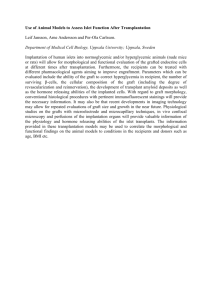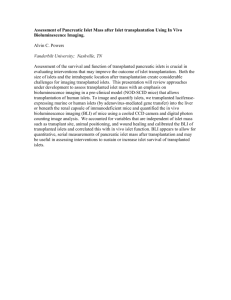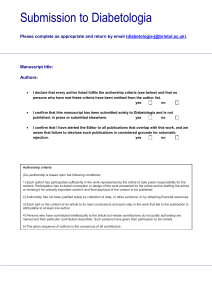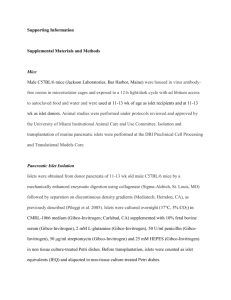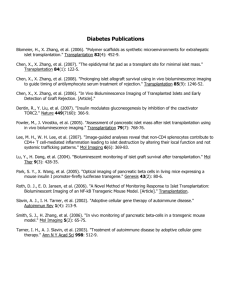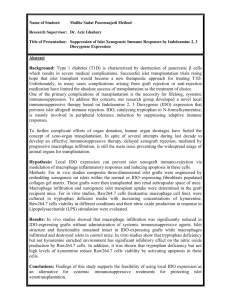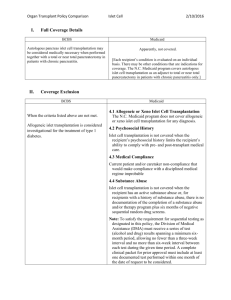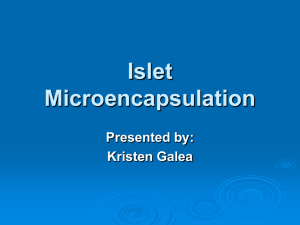Transplantation of human islets without immunosuppression Please share
advertisement
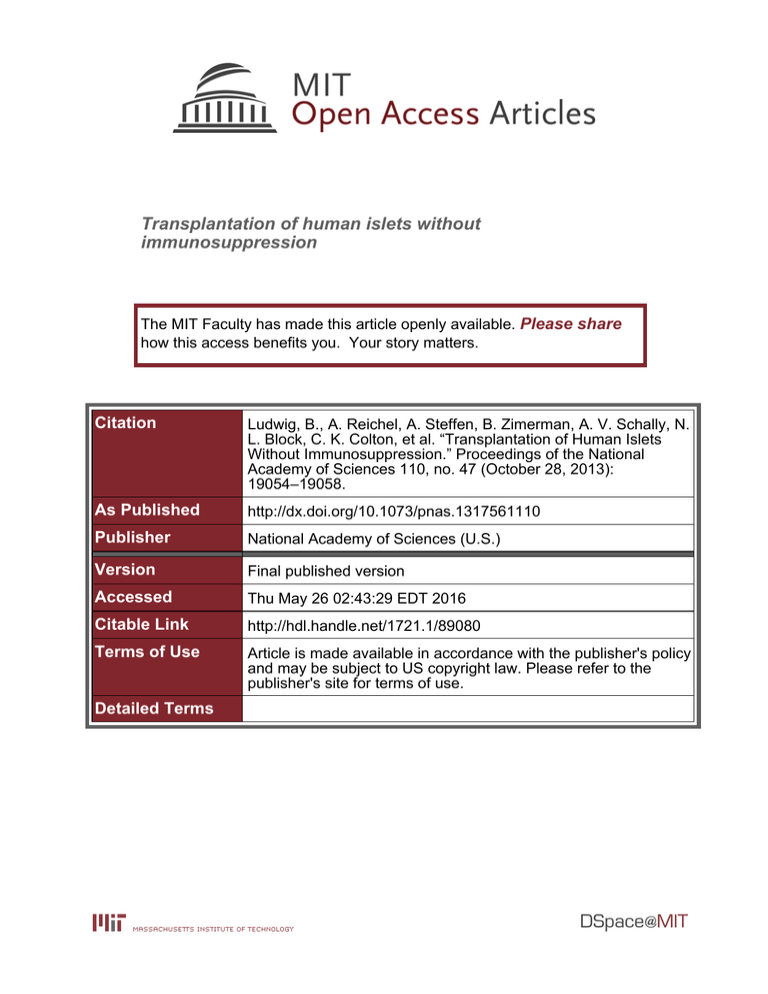
Transplantation of human islets without immunosuppression The MIT Faculty has made this article openly available. Please share how this access benefits you. Your story matters. Citation Ludwig, B., A. Reichel, A. Steffen, B. Zimerman, A. V. Schally, N. L. Block, C. K. Colton, et al. “Transplantation of Human Islets Without Immunosuppression.” Proceedings of the National Academy of Sciences 110, no. 47 (October 28, 2013): 19054–19058. As Published http://dx.doi.org/10.1073/pnas.1317561110 Publisher National Academy of Sciences (U.S.) Version Final published version Accessed Thu May 26 02:43:29 EDT 2016 Citable Link http://hdl.handle.net/1721.1/89080 Terms of Use Article is made available in accordance with the publisher's policy and may be subject to US copyright law. Please refer to the publisher's site for terms of use. Detailed Terms Transplantation of human islets without immunosuppression Barbara Ludwiga,b,1, Andreas Reichela,b,1, Anja Steffena,b, Baruch Zimermanc, Andrew V. Schallyd,e,2, Norman L. Blockd,e, Clark K. Coltonf, Stefan Ludwigg, Stephan Kerstingb,g, Ezio Bonifacioh, Michele Solimenab,i, Zohar Gendlerc, Avi Rotemc, Uriel Barkaic, and Stefan R. Bornsteina,b,j a Department of Medicine III and gDepartment of Visceral, Thorax, and Vascular Surgery, University Hospital Carl Gustav Carus, Technische Universität Dresden, D-01307 Dresden, Germany; bCentre for Diabetes Research, Paul Langerhans Institute Dresden, D-01307 Dresden, Germany; cBeta-O2 Technologies, Petach Tikva 49511, Israel; dDivisions of Endocrinology and Hematology–Oncology, Departments of Pathology and Medicine, University of Miami Miller School of Medicine, Miami, FL 33136; eVeterans Administration Medical Center, Miami, FL 33125; fDepartment of Chemical Engineering, Massachusetts Institute of Technology, Cambridge, MA 02139; hCenter for Regenerative Therapies Dresden, Technische Universität Dresden, D-01307 Dresden, Germany; i Max Planck Institute of Molecular Cell Biology and Genetics, D-01307 Dresden, Germany; and jDepartment of Endocrinology and Diabetes, King’s College, London SE5 9RJ, England Contributed by Andrew V. Schally, September 20, 2013 (sent for review August 15, 2013) Transplantation of pancreatic islets is emerging as a successful treatment for type-1 diabetes. Its current stringent restriction to patients with critical metabolic lability is justified by the long-term need for immunosuppression and a persistent shortage of donor organs. We developed an oxygenated chamber system composed of immune-isolating alginate and polymembrane covers that allows for survival and function of islets without immunosuppression. A patient with type-1 diabetes received a transplanted chamber and was followed for 10 mo. Persistent graft function in this chamber system was demonstrated, with regulated insulin secretion and preservation of islet morphology and function without any immunosuppressive therapy. This approach may allow for future widespread application of cell-based therapies. β-cell replacement | immune barrier | oxygenation T he transplantation of isolated islets of Langerhans has evolved into a successful method to restore endogenous insulin secretion and stabilize glycemic control without the risk of hypoglycemia (1, 2). However, due to persistent lack of human donor pancreata and the requirement of chronic immune suppression to prevent graft rejection through allo- and autoimmunity, the indication for islet transplantation is restricted to patients with complete insulin deficiency, critical metabolic lability, and repeated severe hypoglycemia despite optimal diabetes management and compliance (3). Furthermore, progressive loss of islet function over time due to chronic hypoxia and inflammatory processes at the intraportal transplantation site remain additional unresolved challenges in islet transplantation (4, 5). When islets are immune-isolated, the lack of oxygen impairs the survival and long-term function of the cells. Experimental approaches to overcome this impediment have involved the implantation of hypoxia-resistant islets, stimulation and sprouting of vessels, and the use of islets designed to contain an intracellular oxygen carrier as well as local oxygen production by electrochemical processes or photosynthesis (6). However, so far, none of these methods have been capable of guaranteeing an adequate physiological oxygen concentration or to allow, at the same time, an adequate immunoprotective environment. To overcome these major obstacles, we have developed a strategy for islet macroencapsulation that provides sufficient immune isolation and permits endogenously regulated islet graft function. Here we demonstrate a system that allows a controlled oxygen supply to the islet graft by means of an integrated oxygen reservoir that can be refilled regularly and can maintain oxygen pressure. Earlier we demonstrated that a sufficient supply of oxygen for maintaining optimal islet function can simultaneously ensure functional potency and immunoprotective characteristics of the device. After application of this bioartificial pancreas system in allogeneic and xenogeneic preclinical diabetes models 19054–19058 | PNAS | November 19, 2013 | vol. 110 | no. 47 (7–9) the method was then applied to allogeneic human islet transplantation in an individual treatment approach in a patient with long-term type-1 diabetes. The objective of this study was to determine whether the islet allograft could survive over a prolonged follow-up period, without any immunosuppressive therapy, and could maintain glucose responsiveness. Furthermore, biocompatibility of the macrocapsule and the practicability of the oxygen refilling procedure in daily life were evaluated. Results Type-1 Diabetes C Peptide-Negative Patient. We studied a 63-y-old male patient [weight 74 kg, height 1.75 m, body mass index (BMI) 24.5 kg/m2] with a history of type-1 diabetes for 54 y. He has been seen regularly in our outpatient diabetes clinic for more than 20 y and treated by continuous insulin infusion therapy for 20 y. Despite long-standing autoimmune diabetes he shows no severe secondary diabetes complications, although his metabolic lability has increased over the last several years. Overall glycemic control was acceptable with an average hemoglobin A1c of 7.4% and an average daily insulin requirement of 52 international units (IU)/d. Before enrollment, an i.v. glucose tolerance test (ivGTT) was performed to verify complete insulin deficiency (nondetectable basal or stimulated C peptide). Before transplant, the patient had insulin antibodies (10.7 IU/mL) and, as is Significance Diabetes mellitus type 1 is an autoimmune disease that results in irreversible destruction of insulin-producing beta cells. Substantial advances have been made in beta cell replacement therapies over the last decades. However, lack of eligible donor organs and the need for chronic immunosuppression to prevent rejection critically limit a widespread application of these strategies. In this paper we present the clinical success of using a bioartificial pancreas for the transplantation of insulinproducing islets without affecting the immune system. In a patient with long-standing type-1 diabetes we could demonstrate persistent graft function and regulated insulin secretion without the need for immune-modulating medication. This strategy opens up avenues for more widespread and safe application of various cell-based therapies. Author contributions: B.L., A. Reichel, A.S., B.Z., C.K.C., S.L., S.K., E.B., M.S., Z.G., A. Rotem, U.B., and S.R.B. designed research; B.L., A. Reichel, A.S., B.Z., C.K.C., S.L., S.K., E.B., M.S., A. Rotem, U.B., and S.R.B. performed research; B.L., A. Reichel, A.S., B.Z., A.V.S., N.L.B., E.B., M.S., Z.G., A. Rotem, U.B., and S.R.B. analyzed data; and B.L., A. Reichel, A.S., B.Z., A.V.S., N.L.B., E.B., M.S., Z.G., A. Rotem, U.B., and S.R.B. wrote the paper. The authors declare no conflict of interest. 1 B.L. and A. Reichel contributed equally to this work. 2 To whom correspondence should be addressed. E-mail: andrew.schally@va.gov. www.pnas.org/cgi/doi/10.1073/pnas.1317561110 Transplantation Procedure. The transplantation of the macrochamber containing the islet graft was performed under general anesthesia. The preperitoneal pocket for the chamber was bluntly dissected through a 10-cm midline abdominal incision; one additional small abdominal incision was made close by for implantation of the oxygen ports (Fig. 1B). The chamber and the port system were connected via s.c. tunnelled polyurethane tubes. The patient received antibiotic prophylaxis; no immunosuppressive or anti-inflammatory agents were administered. Surgery was straightforward and without complications. Systemic pain treatment was only required for the first 2 days following implantation. As detected by ultrasound, local edema around the device developed on day 3 and resolved only after 2 wk. The patient did not report any discomfort due to the implanted chamber. No effect of the foreign material was perceptible in daily life, and there was no impact on mobility. For sufficient oxygen supply despite a nonvascularized and therefore immune-shielded islet graft, the gas reservoir integrated in the chamber was replenished daily by puncturing of the adjacent s.c. oxygen port (Fig. 1A). For controlled gas exchange an automated tabletop injection device was used. The procedure was performed by the patient at home. The two implanted ports were changed every other day by the patient. No local skin irritations or infections were observed. Evaluation of in Vivo Graft Function. Graft function was evaluated by frequent blood glucose measurements, determination of systemic basal and stimulated C peptide (ivGTT), and local stimulation of hormone release from the encapsulated islet graft following glucose instillation (Fig. 2). We demonstrated persistent graft function throughout the follow-up period of 10 mo by detection of positive basal C peptide (0.04 ± 0.03 nmol/L at 1, 3, 6, and 9 mo posttransplantation). However, the basal hormone levels were at very low concentrations, and during i.v. glucose stimulation (0.3 g/kg body weight over a 2-min period), C peptide increased to a maximum of 0.8 ± 0.02 nmol/L. These hormone levels are below the physiologic range of stimulated C-peptide secretion but provide direct evidence of successful graft function (Fig. 2A). Local Assessment of Graft Function Following High-Glucose Challenge. To assess the effective capacity of the encapsulated islet graft, a high-glucose solution (15 mmol/L) was instilled locally around the chamber system under ultrasound control. Samples were taken for up to 180 min and assayed for C peptide, insulin, and proinsulin. A rapid insulin secretion response was observed, demonstrating proof of islet viability via responsiveness to glucose (Fig. 2B). This direct evidence of allogeneic graft function was accompanied by a persistent lowering in hemoglobin A1c (Fig. 2C) during the implantation period along with a reduction in insulin requirement (total insulin requirement pretransplantation 52 ± 5.8 IU/d versus posttransplantation 43 ± 4.9 IU/d). Immune Assessment. No change in islet autoantibody and donor alloantibody status compared with pretransplantation was seen during the follow-up. Glutamatic acid decarboxylase (GAD), tyrosine phosphatase-like protein (IA2), and islet cell (ICA) antibodies remained negative, and the pretransplant positive titer for insulin antibodies (10.7 IU/mL) did not change during the follow-up (10.3 IU/mL at 9 mo posttransplantation). Donorspecific antibodies remained negative at 3 and 9 mo posttransplantation. Memory T cells remained unresponsive to glutamic acid decarboxylase 65 and to proinsulin at 5 d and at 9 mo posttransplant. Ex Situ Postexplantation Study. At 10 mo following transplantation the chamber system containing the macroencapsulated allogeneic human islets graft was explanted and assessed for overall integrity, islet morphology, and function. The implantation site appeared as a thin fibrous capsule, macroscopically and microscopically noticeably well vascularized and without any signs of inflammation. Before disassembly, the complete chamber system (Fig. 3A) was submersed in Ringers lactate solution containing 15 mmol/L glucose for testing responsiveness to glucose ex situ. As shown in Fig. 2D, islets showed rapid insulin and C-peptide secretion in response to mild glucose challenge. After disassembly of the chamber, islet slabs were analyzed by dithizone staining and immunohistochemistry (Fig. 3). Morphologically, we saw well-preserved intact islet structures with intense staining following exposure to the zinc-binding isletspecific dye, dithizone (Fig. 3B). Immunohistochemical staining for insulin and glucagon showed the typical cell composition of alpha and beta cells within the islet structures (Fig. 3C). Fig. 1. Chamber system for macroencapsulation of islets. (A) Schematic view of the chamber system. The core of the device is built as a gas module, connected to access ports for exogenous oxygen refilling. Separated by gaspermeable membranes, two compartments surround the gas module that houses pancreatic islets immobilized in alginate. The plastic housing of the chamber gives mechanical stabilization to the islets module located in the cutoffs. The plastic housing as well as the islet module is covered by hydrophylic polytetrafluorethylene (PTFE) porous membranes allowing the islets to sense the recipient’s glucose levels. (B) Chamber system with integrated human islet graft with connected access ports before implantation. Ludwig et al. Discussion The concept of islet macroencapsulation has been successfully proven in different transplant models in small and large animals with regard to biocompatibility, efficacy, and sufficient immunoprotection (7–9). Here we show that allogeneic human islets, inside a chamber system that immunologically separates the islet graft from the recipient and integrates continuous adequate oxygen supply, can survive and maintain glucose responsiveness 10 mo after PNAS | November 19, 2013 | vol. 110 | no. 47 | 19055 MEDICAL SCIENCES often seen in patients with long-term type-1 diabetes, was negative for autoantibodies to glutamate decarboxylase 65, islet cell– antigen 2, and islet cell antibodies. Luminex-based measurements of donor-specific antibodies (anti-HLA class I and II) were undetectable. Peripheral blood memory T cells did not show a proliferative response to the islet antigens, glutamic acid decarboxylase 65, or to proinsulin. Fig. 2. Functional assessment of macroencapsulated human islets. (A) Systemic C-peptide measurement during i.v. glucose tolerance test at 3, 6, and 9 mo after transplantation. (B) Local islet graft stimulation by injection of a 15-mmol glucose solution into the implantation pocket under ultrasound control and sampling for measurement of local hormone concentrations. (C) Hemoglobin A1c levels prior and after islet transplantation demonstrating a persistent improvement in glycemic control. (D) Ex situ stimulation of the intact chamber system containing the islet graft after retrieval at 10 mo. transplantation into a patient with type-1 diabetes. Despite the absence of using any immunosuppressive agents, no signs of graft rejection or immune sensitization of the recipient were observed. Although the islets were functional over the entire period of 10 mo, only moderate improvements on clinical disease were observed. These included improvement in hemoglobin A1c and reduction in insulin requirement. The low basal and stimulated C peptide may be partly explained by the minimal mass of islets transplanted [2,100 islet equivalents (IEQ)/kg body weight]. Most clinical protocols define the lower threshold for human islet transplantation as 5,000 IEQ/kg body weight, and analysis of larger cohorts of patients following islet transplantation suggests that a minimal mass of 10,000 IEQ/kg body weight is required to achieve insulin independence, at least temporarily (1, 2, 4, 5, 10, 11). Other potential causes of a minimal systemic effect include the qualities of the transplantation site and barriers to diffusion. As we showed previously, the combined barrier structure of the chamber system allows for free diffusion of glucose and only marginally attenuated insulin diffusion. The subperitoneal space as a transplantation site affords a highly vascularized and metabolically active tissue that should provide a favorable interchange. However, for minimization of diffusion barriers, placement of the chamber into an omental pouch could be a more promising alternative which might further promote the clinical effectiveness of the device. Another important option to improve the functioning of the graft could involve a preconditioning of pancreatic islets before transplantation using potent new agonists of growth hormonereleasing hormone (GHRH) (6, 9, 12) or inclusion or addition of 19056 | www.pnas.org/cgi/doi/10.1073/pnas.1317561110 these GHRH agonists to the chamber during transplantation. We have previously shown that pretreatment with GHRH agonists significantly enhances graft function by improving glucose tolerance and increasing β-cell insulin reserve in rats. This may allow a reduction of the required islet mass in the oxygenated chamber with simultaneously improved metabolic control once these GHRH agonists are available for clinical use. It has been repeatedly shown that native pancreatic islets have a disproportionately high level of vascularization (13–18). During the process of islet isolation their vasculature is disrupted, and after transplantation the islets depend on oxygen diffusion from tissue surrounding the transplantation site until revascularization has occurred. Hypoxia, however, has significant deleterious effects on the survival and function of the islet graft (19). The concept of supplying augmented oxygen to the islets by integration of a gas reservoir in the chamber system addresses a key prerequisite for long-term islet function without compromising the immune-barrier effect. We have demonstrated here that the procedure of daily exogenous oxygen refilling is feasible and well tolerated. However, it requires a knowledgeable and compliant patient and is an issue that will be addressed in the further development of the system. Possible approaches are the integration of artificial or naturally occurring intrinsic oxygen producers such as algae species. A major drawback of islet transplantation is the persistent shortage of high-quality donor organs. Xenotransplantation using cells and tissue of pigs or other species is considered to be a potential solution for this problem (20). Xenotransplantation is, however, highly challenging with respect to safety and immunologic perspectives. The ability of the system presented here to Ludwig et al. Fig. 3. Human islet graft after explantation. (A) Retrieved chamber system containing the islet graft slabs. Islets were macroscopically intact and showed (B) an intense staining after dithizone exposure. (C) Islets showed intact morphologic structure and stained immunohistochemically for insulin (green), and glucagon (red) showed alpha and beta cells regularly and normally distributed (magnification, 40×). Materials and Methods Bioartificial Pancreas. The detailed construction of the chamber system used for islet macroencapsulation was previously described (6, 7–9). Briefly, the device is 68 mm in diameter and 18 mm in thickness (Fig. 1A), composed of a 600-μm-thick immobilized islets module attached to an oxygen module by a gas-permeable silicon-rubber membrane. The oxygen module is composed of three compartments: a central and two side compartments separated by silicon-rubber membranes. The central compartment is connected to two polyurethane access ports implanted s.c. (Fig. 1B). A gas mixture containing 95% (vol/vol) O2 at 1.4 atm and 5% (vol/vol) CO2 is daily refilled into the central compartment. Oxygen diffuses from the central compartment across the silicon membranes into the side compartments and then toward the islet compartments where it diffuses into the aqueous milieu of the alginate hydrogel containing the islets, thus providing an adequate oxygen supply for them. The plastic housing of the chamber provides mechanical protection to the islet modules. The outside of the chamber consists of hydrophilic 0.4-μm porous polytetrafluoroethylene (PTFE) membranes and is impregnated with hydrophobically modified (HM) alginate to prevent immunologic communication between the recipient and the graft tissue (Fig. 1 A and B). Patient Criteria and Islet Isolation Procedure. A 63-y-old type-1 diabetic patient with nondetectable C-peptide levels participated in this trial. The patient himself is a mathematician and has been involved in the development of diabetes technology and artificial pancreata for many years. He was fully informed about this “individual treatment attempt” and gave written consent to the procedure according to the rules and regulations of the institutional ethic committee and legal office of the Technische Universität Dresden. According to German regulations, donor pancreas is only allocated for whole organ transplantation, but can be used for the isolation of islets when the whole organ pancreas is not accepted at any applicable transplant Ludwig et al. center (according to German transplantation law). Consent for organ and tissue transplantation was obtained from next of kin and authorization by Eurotransplant. The donor was a 56-y-old male with a BMI of 27 kg/m2, no history of diabetes, an intensive care unit time of 96 h, a mild requirement for catecholamines, and no relevant abnormal laboratory results. Donor and recipient were compatible for blood type, and cross-match result was negative. After cold ischemia time of 8 h, islets were isolated using a modification of the automated Ricordi method (21). After overnight culture, islets were assessed for yield and purity. The islet count was insufficient for regular islet transplantation, and the preparation was assigned for macroencapsulation and transplantation. The calculated islet mass transplanted was 2,100 IEQ/kg body weight. Immunohistochemistry. Paraffin serial sections were taken for morphological assessment after device retrieval. Sections were incubated with guinea pig anti-insulin (Abcam) and mouse anti-glucagon (Sigma) followed by Alexa488– goat anti-guinea pig and Alexa568–goat anti-mouse antibodies. The nuclei were counterstained using DAPI (Enzo Life Science). Images were acquired by Zeiss LSM510 confocal microscopy using 40× magnification. Immune Assessment. The detection of anti-HLA class I and anti-HLA class II antibodies was performed using Luminex-based antibody differentiation analyses (Lifecodes class I/II ID, via Inno-Train). Memory T-cell responses to glutamatic acid decarboxylase 65 (GAD65) and to proinsulin were measured by a dye proliferation assay. Peripheral blood mononuclear cells were isolated using Ficoll gradient. Cells were washed, and the CD45RA+ T cells were depleted using CD45–phycoerythrin (PE) and anti-PE magnetic beads (Miltenyi Biotech). The remaining CD45RA+ depleted cells were stained with the eFluor 670 dye (eBioscience), washed, and incubated in medium alone, medium containing 10 μg/mL proinsulin (Lilly) or 10 μg/mL GAD65 (Diamyd). After 5 d, cells were stained for CD4–FITC and CD25–PE and analyzed on an LSR II analyzer (Becton Dickinson). Responding cells were identified as CD4+ eFluor 670dim CD25+. Measurement of autoantibodies against insulin, glutamate decarboxylase 65, and islet cell–antigen 2 was performed by ELISA technique (Medipan). Quantification of islet cell antibodies was done by indirect immunofluorescence (Euroimmun). Assessment of Graft Function. In vivo graft function was assessed by standard i.v. glucose tolerance test at 3, 6, and 9 mo after transplantation. For the local graft stimulation in vivo, 15 mmol glucose solution was injected into the PNAS | November 19, 2013 | vol. 110 | no. 47 | 19057 MEDICAL SCIENCES protect allogeneic islets from immune attack without manipulation of the recipient’s immune system as well as the findings in our previous preclinical xenotransplantation studies provide promising evidence that the chamber system has the potential to evolve into a successful and safe approach for clinical application of cell-based therapies, including cells from xenogeneic sources. implantation pouch under ultrasound control, and samples were taken at given time points. After retrieval of the device at 10 mo the intact device was stimulated in 15 mmol Kreb’s Ringer buffer (137 mM NaCl, 4.7 mM KCl, 1.2 mM KH2PO4, 1.2 mM MgSO4*7H2O, 2.5 mM CaCl2*2H2O, 25 mM NaHCO3, 0.25% BSA) for 1 h. Levels of ex situ C peptide and proinsulin were measured by standardized specific enzyme-linked immunosorbent assays (Mercodia and ZenTech). Levels of in vivo insulin and C peptide were measured by standardized chemiluminescence immunoassay (DiaSorin). Hemoglobulin A1c was determined by a Biorad laboratory test kit. ACKNOWLEDGMENTS. We thank Susann Lehmann from the B.L. laboratory for immunohistochemical stainings. Special thanks go to the team of Prof. Sybille Bergmann (Institute for Clinical Chemistry, University Hospital Dresden) for hormone analyses. Furthermore, we thank the Institute for Immunology, Technische Universität Dresden, for autoantibody measurements and the HLA laboratory, University Hospital Halle (Saale) for Luminex analyses. This study was supported by Deutsche Forschungsgemeinschaft BR1179 (to B.L.) and SFB/TR127 (to S.R.B. and B.L.) and the German Ministry for Education and Research (BMBF) (to the German Centre for Diabetes Research). 1. CITR Research Group (2009) 2007 update on allogeneic islet transplantation from the Collaborative Islet Transplant Registry (CITR). Cell Transplant 18(7): 753–767. 2. McCall M, Shapiro A-M (2012) Update on islet transplantation. Cold Spring Harb Perspect Med 2(7):a007823. 3. Ludwig B, Ludwig S, Steffen A, Saeger H-D, Bornstein S-R (2010) Islet versus pancreas transplantation in type 1 diabetes: Competitive or complementary? Curr Diab Rep 10(6):506–511. 4. Shapiro A-M (2011) Strategies toward single-donor islets of Langerhans transplantation. Curr Opin Organ Transplant 16(6):627–631. 5. Shapiro A-M, et al. (2006) International trial of the Edmonton protocol for islet transplantation. N Engl J Med 355(13):1318–1330. 6. Ludwig B, et al. (2012) Improvement of islet function in a bioartificial pancreas by enhanced oxygen supply and growth hormone releasing hormone agonist. Proc Natl Acad Sci USA 109(13):5022–5027. 7. Barkai U, et al. (2013) Enhanced oxygen supply improves islet viability in a new bioartificial pancreas. Cell Transplant 22(8):1463–1476. 8. Ludwig B, et al. (2010) A novel device for islet transplantation providing immune protection and oxygen supply. Horm Metab Res 42(13):918–922. 9. Neufeld T, et al. (2013) The efficacy of an immunoisolating membrane system for islet xenotransplantation in minipigs. PLoS ONE 8(8):e70150. 10. Berney T, Johnson P-R (2010) Donor pancreata: Evolving approaches to organ allocation for whole pancreas versus islet transplantation. Transplantation 90(3): 238–243. 11. Shapiro A-M, et al. (2000) Islet transplantation in seven patients with type 1 diabetes mellitus using a glucocorticoid-free immunosuppressive regimen. N Engl J Med 343(4):230–238. 12. Schubert U, et al. (2013) Transplantation of pancreatic islets to adrenal gland is promoted by agonists of growth-hormone-releasing hormone. Proc Natl Acad Sci USA 110(6):2288–2293. 13. Chin K, Khattak S-F, Bhatia S-R, Roberts S-C (2008) Hydrogel-perfluorocarbon composite scaffold promotes oxygen transport to immobilized cells. Biotechnol Prog 24(2):358–366. 14. Johnson A-S, et al. (2011) Quantitative assessment of islets of Langerhans encapsulated in alginate. Tissue Eng Part C Methods 17(4):435–449. 15. Lau J, Carlsson P-O (2009) Low revascularization of human islets when experimentally transplanted into the liver. Transplantation 87(3):322–325. 16. Lehmann R, et al. (2007) Superiority of small islets in human islet transplantation. Diabetes 56(3):594–603. 17. Lifson N, Kramlinger K-G, Mayrand R-R, Lender E-J (1980) Blood flow to the rabbit pancreas with special reference to the islets of Langerhans. Gastroenterology 79(3):466–473. 18. Papas K-K, et al. (2007) Human islet oxygen consumption rate and DNA measurements predict diabetes reversal in nude mice. Am J Transplant 7(3):707–713. 19. Dionne K-E, Colton C-K, Yarmush M-L (1993) Effect of hypoxia on insulin secretion by isolated rat and canine islets of Langerhans. Diabetes 42(1):12–21. 20. Cooper D-K, Koren E, Oriol R (1994) Clinical potential of xenotransplantation. Transplant Proc 26(3):1331–1332. 21. Ricordi C, Lacy P-E, Finke E-H, Olack B-J, Scharp D-W (1988) Automated method for isolation of human pancreatic islets. Diabetes 37(4):413–420. 19058 | www.pnas.org/cgi/doi/10.1073/pnas.1317561110 Ludwig et al.
